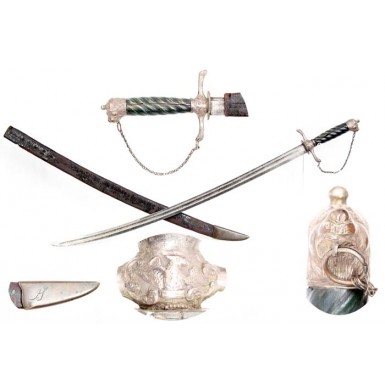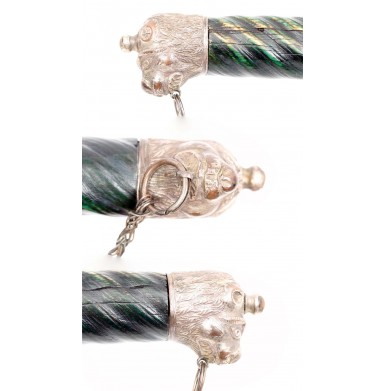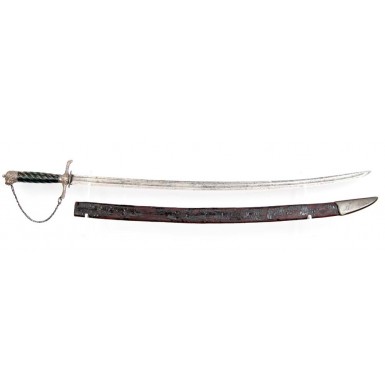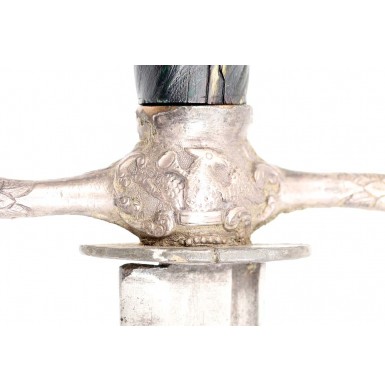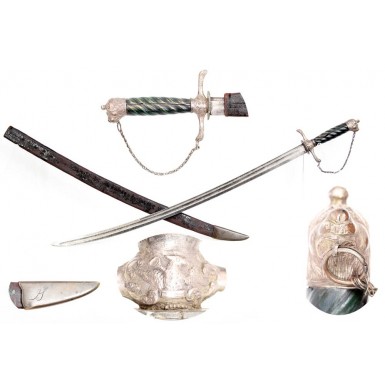Baltimore Style American Hunting Sword
- Product Code: EWSK-1382-SOLD
- Availability: Out Of Stock
-
$1.00
This is a lovely example of what collectors often refer to as a “Baltimore” Style American Hunting Sword (or Cuttoe), from the Revolutionary War era. These American made swords were based upon the English swords of the same basic pattern. The English “hunting sword” pattern had evolved from the European hunting sword, which had morphed from a short, straight bladed sword with a rigid hand guard (c1710-1740) to a slightly longer, curved blade sword with a chain hand guard (c1740-1760). The European swords usually had shorter blades than their English contemporaries, and the American made swords tended to have still slightly longer blades than the English examples from the same era. The swords were originally intended to dispatch wounded animals at the end of chase (hence the name), and as such were lighter and smaller than swords intended for combat with 2-legged beasts. As the style of sword became more and more popular with Colonial militia officers during the 1750s and 1760s, the American sword became slightly more substantial than its English and European counterparts. Even though they were worn more as a badge of rank by Colonial officers than as actual fighting weapons, the swords started to become more robust than the European and English versions, allowing the swords to be used as weapons, if necessary. By the 1770s, the form had become an extremely popular American sword and many high quality cutlers and silversmiths offered well-executed examples, often with lion or eagle head pommels, for sale to militia and eventually Continental Army officers. Renowned makers like John Bailey in New York, William Moulton in Massachusetts (and late New Hampshire) and Seril Dodge in Rhode Island all produced exquisite examples of these swords from in the years leading up to the Revolutionary War, as well as during it. These makers often relied upon imported blades or older, repurposed blades, in addition to locally produced blades, and then hilted them with finely crafted animal head pommels, often in silver. Lower cost examples were also produced with brass or copper hilts and plated with silver rather than being made from sterling silver. These swords were perfect for lower ranking company grade officers, who were not normally as well off as their line and staff officer grade superiors.
This Baltimore Style Hunting Sword was likely produced during the Revolutionary War era (circa 1780), and is one of the cheaper, silver plated examples. The sword has the typical Lion’s Head pommel, but appears to be cast in red brass or copper, and was then silver-plated. Some areas of loss to the plating clearly reveal the reddish copper coloration of the metal under the plating. The sword is 3 13/8” in overall length, with a 25 ““ long blade that is 1” wide at the ricasso. The blade has two fullers, one is about 17” long, is fairly narrow, and runs just below the spine of the blade. This fuller terminates at the beginning of an 8 ““ long false edge. The second fuller is in the center of the blade and runs almost the entire length of the blade. The fuller is 25” long and is tapered at both ends. It runs from just in front of the guard to just shy of the tip o the sword. The hilt is 5 5/8” in length, and as mentioned has a silver-plated Lion’s Head pommel. The guard is small oval that is approximately 1 9/16” x 7/8”, which is based by a slightly “S’ shaped guard cast in the motif of swans heads. This pattern of guard is a well-known English style, and is one that was often copied in the colonies. What makes the guard special are the “Chicken Neck” eagle (early American version of the US Eagle) motifs that are centered on both sides of the guard. The obverse shows a spread-winged eagle with its head facing to the left, with a trumpet issuing from its breast, and with flowing scrolls below it. The “eagle” looks more like a pterodactyl than an eagle, but it is an early version. The reverse shows an enlarged version of this scrawny “chicken neck” eagle, surrounded by panoply of scrolls, arms and trumpets. This hilt motif is considered to be from the Baltimore area, circa 1775-1785. Like the pommel, the hilt is cast in brass or copper and has been silver-plated. The grip is made from ivory, which has been carved with diagonal grooves, encircling the grip running from the hilt to the pommel. The ivory has been dyed green and is quite striking. A simple chain guard runs from the mouth of the lion to the mouth of the lower swan on the guard. As is so typical of these early American swords, the sword is unmarked. The sword is contained within what appears to be its original leather scabbard. The scabbard has a brass drag with the single letter G engraved on the obverse in a lovely period script. The sword is light and handy, weighing in at about 14 ounces (without the scabbard), and is well balanced.
The overall condition of this attractive, Early American Baltimore-Style Cuttoe is about VERY GOOD+ to NEAR FINE. The sword is in good solid condition, with only minimal wiggle at the hilt to blade juncture. The blade appears to be full length and unaltered. Although it was probably lightly sharpened during the period of service and lightly cleaned long ago, the blade appears relatively unmolested, and has a pleasing medium pewter-gray patina overall. The blade shows light to moderate peppering scattered over its entire length, as well as scattered patches of light surface oxidation and discoloration. The blade also shows some scattered patches of light pinpricking, scattered along its length. There are several very small nicks along the cutting edge of the blade, some are visible with the naked eye and some can simply be felt as you run your fingers along the edge (gently please!). None are substantial or detract from the display of the sword, but are simply indications that the sword saw some real use and service. The hilt has lovely, untouched appearance. The silver plated guard and pommel are lightly tarnished and show darker tarnish in the recesses of the decorative engraved motifs, especially in the detailing in the Lion’s Head. The Lion's Head retains about 80%+ of its silver plated finish, with the majority of the loss from wear along high edges and contact points. The guard retains about 95% of its silver plated finish, with the loss primarily around the joint between the guard and the grip. There is a 6” silver chain hand guard running from the mouth of the lion’s head to the mouth of the lower swan’s head of the guard. The finely woven chain is attractive and correct in styling, but may be a more recent replacement. The two split rings that secure the chain to the animal mouths are almost certainly modern replacements and not of the period. The green dyed, grooved ivory grip shows a number of cracks running its length, and couple of missing chips of ivory. These are very old chips, and time and use have worn them quite smooth. There is some minor wobble at the guard to blade juncture and slightly more wobble is present at the grip. There are no structural issues noted, and the components are all solidly attached to each other, but the minor wobble is noted for exactness. The sword retains what is almost certainly its original leather scabbard, which fits it perfectly. The scabbard is full length and retains about 30% of its original leather finish, the balance having flake and worn off. The remaining finish shows significant cracking and crazing and should be delicately cared for and handled as little as possible. The scabbard face is decorated with simple incised lines that are now only partially visible due to the finish loss. The leather of the scabbard body itself remains strong and supple, and the stitching along the rear seam is solid and tight, appearing to be all original. What appears to be the original brass drag is present at the toe of the scabbard, and it is engraved with the letter G on the obverse. The throat of the scabbard is missing, making it appear that the scabbard is slightly short. The throat was probably made of sheet brass as well, and most likely had a stud on the front to mount the scabbard on a baldric or frog. It goes without saying that the scabbard for any Revolutionary War era sword is extremely rare.
Overall this is a very nice and quite attractive example of a Revolutionary War era Cuttoe, likely carried by an American officer during the conflict. These Baltimore style swords provide us with some of the earliest American Eagle martial motifs and are quite desirable. While the eagle is certainly not as attractive and bold as the later, 19th century American Eagle would become, these scrawny early eagles are an almost symbolic representation of our scrawny little country, trying to spread its wings, throw off the yoke of oppression and eventually grow into the powerful eagle we would become. This is a great early American sword with a scarce original scabbard, that will be a great addition to any collection of Colonial or Revolutionary War era edged weapons, and is a piece you will be very proud to display.
SOLD
